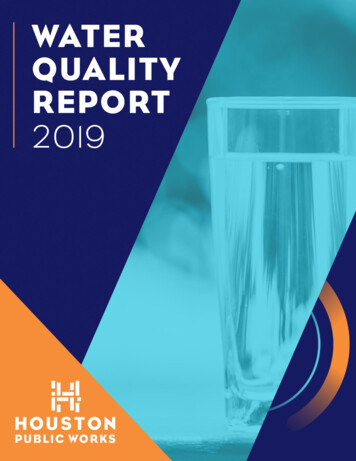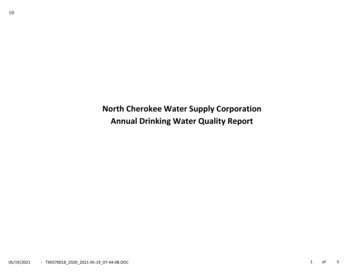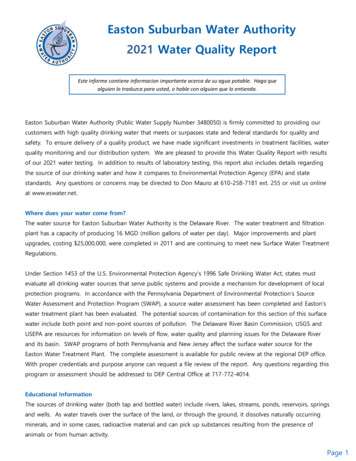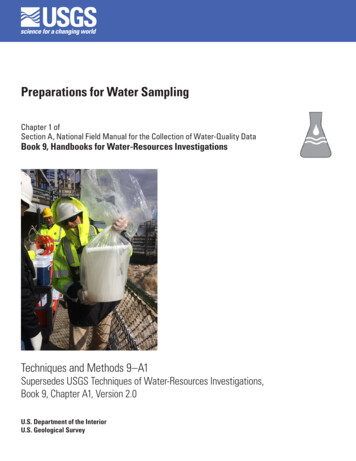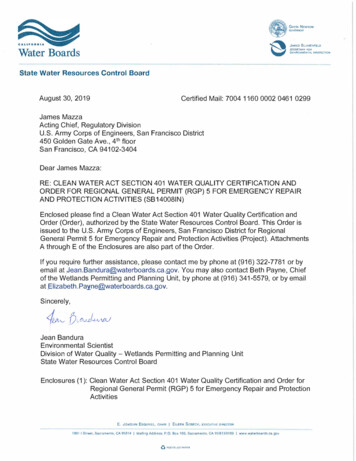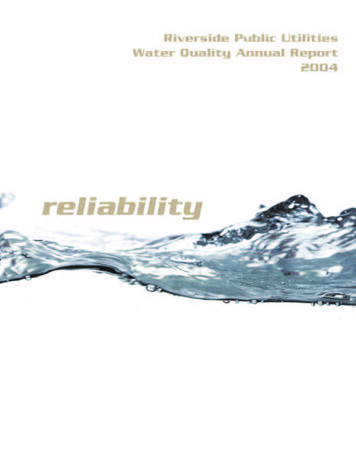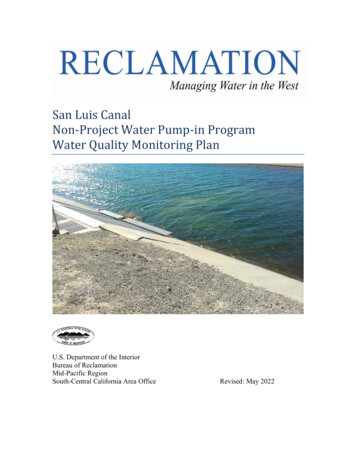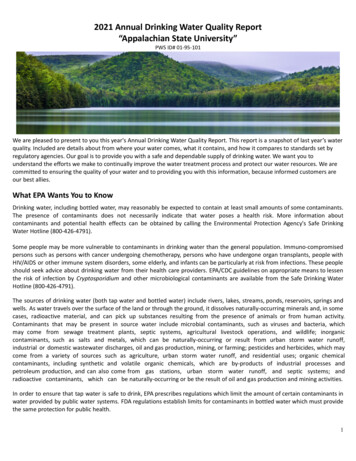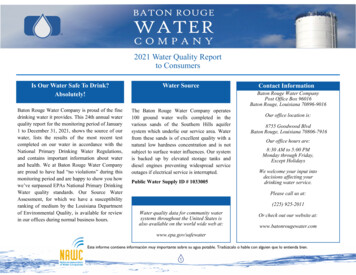
Transcription
2021 Water Quality Reportto ConsumersIs Our Water Safe To Drink?Absolutely!Water SourceBaton Rouge Water Company is proud of the finedrinking water it provides. This 24th annual waterquality report for the monitoring period of January1 to December 31, 2021, shows the source of ourwater, lists the results of the most recent testcompleted on our water in accordance with theNational Primary Drinking Water Regulations,and contains important information about waterand health. We at Baton Rouge Water Companyare proud to have had “no violations” during thismonitoring period and are happy to show you howwe’ve surpassed EPAs National Primary DrinkingWater quality standards. Our Source WaterAssessment, for which we have a susceptibilityranking of medium by the Louisiana Departmentof Environmental Quality, is available for reviewin our offices during normal business hours.The Baton Rouge Water Company operates100 ground water wells completed in thevarious sands of the Southern Hills aquifersystem which underlie our service area. Waterfrom these sands is of excellent quality with anatural low hardness concentration and is notsubject to surface water influences. Our systemis backed up by elevated storage tanks anddiesel engines preventing widespread serviceoutages if electrical service is interrupted.Contact InformationBaton Rouge Water CompanyPost Office Box 96016Baton Rouge, Louisiana 70896-9016Public Water Supply ID # 1033005Our office location is:8755 Goodwood BlvdBaton Rouge, Louisiana 70806-7916Our office hours are:8:30 AM to 5:00 PMMonday through Friday,Except HolidaysWe welcome your input intodecisions affecting yourdrinking water service.Please call us at:(225) 925-2011Water quality data for community watersystems throughout the United States isalso available on the world wide web at:Or check out our website e informe contiene información muy importante sobre su agua potable. Tradúzcalo o hable con alguien que lo entienda bien.
EPA Required Additional Health InformationTo ensure that tap water is safe to drink, EPAprescribes limits on the amount of certaincontaminants in water provided by public watersystems. US Food and Drug Administrationregulations establish limits for contaminants inbottled water.Drinking water, including bottled water, mayreasonably be expected to contain at least smallamounts of some contaminants. The presence ofcontaminants does not necessarily indicate thatwater poses a health risk.As previously stated, our drinking water isdrawn from wells which are not under the influenceof surface water. Other sources of drinking water(both tap water and bottled water) include rivers,lakes, streams, ponds, reservoirs, and springs.As water travels over the land or through theground, it dissolves naturally-occurring mineralsand radioactive material, and can pick upsubstances resulting from the presence of animals orfrom human activity. Contaminants that may bepresent in source water include:(a) Microbial contaminants, such as virusesand bacteria, which may come from sewagetreatment plants, septic systems, agriculturallivestock operations, and wildlife.(b) Inorganic contaminants, such as salts andmetals, which can be naturally-occurring or resultfrom urban storm runoff, industrial or domesticwastewater discharges, oil and gas production,mining, or farming.(c) Pesticides and herbicides, which may comefrom a variety of sources such as agriculture, stormwater runoff, and residential uses.(d) Organic chemical contaminants, includingsynthetic and volatile organics, which are byproducts of industrial processes and petroleumproduction, and can also come from gas stations,urban storm water runoff and septic systems.(e) Radioactive contaminants, which can benaturally-occurring or be the result of oil and gasproduction and mining activities.In order to ensure that tap water is safe to drink,EPA prescribes regulations which limit the amountof certain contaminants in water provided by publicwater systems. FDA regulations establish limits forcontaminants in bottled water which must providethe same protection for public health. Some peoplemay be more vulnerable to contaminants in drinkingwater than is the general population. Immunocompromised persons such as persons with cancerundergoing chemotherapy, persons who haveundergone organ transplants, people withHIV/AIDS or other immune system disorders, someelderly, and infants can be particularly at risk frominfections. These people should seek advice aboutdrinking water from their health care providers.EPA/CDC guidelines on appropriate means tolessen the risk of infection by Cryptosporidium areavailable from the Safe Drinking Water Hotline(800-426-4791).If present, elevated levels of lead can causeserious health problems, especially for pregnantwomen and young children. Lead in drinking wateris primarily from materials and componentsassociated with service lines and home plumbing.Baton Rouge Water Company is responsible forproviding high quality drinking water, but cannotcontrol the variety of materials used in plumbingcomponents. When your water has been sitting forseveral hours, you can minimize the potential forlead exposure by flushing your tap for 30 seconds to2 minutes before using water for drinking orcooking. If you are concerned about lead in yourwater, you may wish to have your water tested.Information on lead in drinking water, testingmethods, and steps you can take to minimizeexposure is available from the Safe Drinking WaterHotline or athttp://www.epa.gov/safewater/lead
What Does the Table Mean?The tables on the following pages were prepared in strict accordance with the United States Environmental Protection Agency National PrimaryDrinking Water Regulation (NPDWR): Consumer Confidence Reports (40 CFR 141 and 142). All testing was done by the Department of Health,State of Louisiana; by the USEPA; or by EPA or State certified laboratories. Information on contaminants reported in the table include the name ofeach substance, the highest level allowed by regulation (MCL), the ideal goals for public health (MCLG), the highest level detected in any sample,the range of levels detected, the usual sources of such contamination as determined by EPA, footnotes explaining our findings, and a key to units ofmeasurement. The data in the report are from the most recent testing done in accordance with the regulations. The EPA or the State requires us tomonitor for certain contaminants less than once per year because the concentrations of these contaminants do not change frequently. Severalimportant definitions are:AL Action Level - Theconcentration of a contaminantwhich, if exceeded, triggerstreatment or other requirementswhich a water system must followTT Treatment Technique - TT ppm Parts per million oris a required process intended tomilligrams per liter (mg/l)reduce the level of a contaminantin drinking waterppt Parts per trillion or ng/lppb parts per billion ormicrograms per liter (μg/l)MCL MaximumContamination Level - Thehighest level of a contaminantallowed in drinking water. MCLsare set as close to the MCLGs asfeasible using the best treatmenttechnologyMRDL Maximum ResidualDisinfectant Level - The highestlevel of a disinfectant allowed indrinking water. There is evidencethat addition of a disinfectanthelps control microbialcontaminantsMCLG MaximumContamination Level Goal - Thelevel of a contaminant in drinkingwater below which there is noknown or expected risk to health.MCLGs allow for a margin ofsafety.MRDLG Maximum ResidualDisinfectant Level Goal - Thelevel of a drinking waterdisinfectant below which there isno known or expected risk tohealth. MRDLGs do not reflectthe benefits of the use ofdisinfectants to control microbialcontaminantsntu nephelometric turbidityunits (a measure of turbidity).
Range of DetectsLowestHighest Major Sources202.4Discharge from petroleum refineries; fire retardants; ceramics;electronics; solderRegulated ContaminantsAntimony, ium6/23/2020NOppb100ND.32Erosion of natural deposits; runoff from orchards; runoff from glassand electronics production wastes.Fluoride1/25/2021NOppm44ND0.80Erosion of natural deposits; water additive which promotes strongteeth; discharge from fertilizer and aluminum noff from fertilizer use; leaching from septic tanks, sewage;erosion of natural 9NOppb44NDRegulated ContaminantsRadionuclidesCombined Radium (-226 & ss Alpha Particle Activity7/29/2020NOpCi/L150ND4.38Erosion of natural depositsGross Beta Particle Activity10/24/2019NOpCi/L500ND4.76Decay of natural and man-made deposits. Note: The gross betaparticle activity MCL is 4 millirems/year annual dose equivalent tothe total body or any internal organ. 50 pCi/L is used as a screeninglevel.0.00089 Discharge from petroleum factories.0.22Herbicide runoff.Range of DetectsLowestHighest Major Sources2ND1.01Erosion of natural depositsNotes to accompany table:1“Units” have been modified from the traditional MCL reporting units of mg/l to units which provide detected level numbers greater than one (1). This has been done to comply with the EPArequirements for this report. Use caution when comparing detected levels in this table to MCLs listed elsewhere.2“Major Sources” were taken verbatim from the EPA regulation. We have no data to indicate there are any local/manmade sources of these contaminants in our water.(AL Action Level; MCL Maximum Contaminant Level; MCLG Maximum Contaminant Level Goal; ND Not Detected; MRL Minimum Reporting Level; pCi/L Pico curies per liter;ppm parts per million milligrams per liter; ppb parts per billion micrograms per liter; ppt parts per trillion (ng/l); LRAA Locational Running Annual Average.)
Regulated ContaminantsChloraminesDate2021HighestRAA2Range of DetectsLowestHighest0.512.61Unit1ppmMRDL MRDLG44Period20212021HighestLRAA RangeUnit10-1.61ppb10.45-1.6 ppbMajor Sources2Water additive used to control microbesDisinfection ByproductsTotal Haloacetic Acids (HAA5)Total Haloacetic Acids (HAA5)Sample Point14061 Troy Duplessis40250 Pelican PointTotal Haloacetic Acids (HAA5)9526 Arleen Dr202120 - 5.4ppb600By-product of drinking water disinfectionTotal Haloacetic Acids (HAA5)Gen Ben Davis @ Vets202110 - 2.3ppb600By-product of drinking water disinfectionTTHMTTHMTTHMTTHM14061 Troy Duplessis40250 Pelican Point9526 Arleen DrGen Ben Davis @ Vets202120212021202110.4320 - 0.990 - 0.830 - 6.51.3 - 2.0ppbppbppbppb808080800000By-product of drinking water chlorinationBy-product of drinking water chlorinationBy-product of drinking water chlorinationBy-product of drinking water chlorinationLead and CopperLeadDate2019ViolationNOUnregulated contaminates are those that don’t yet have a drinking waterstandard set by USEPA. The purpose of monitoring for these contaminants is to help USEPA decide whether the contaminants should have astandard.The 1996 Safe Drinking Water Act (SDWA) amendments require thatonce every five years EPA issue a new list of no more than 30 unregulatedcontaminants to be monitored by public water systems (PWSs)Unit1ppb90thPercentile2AL15Unregulated ContaminantsMCL MCLG Typical Source600By-product of drinking water disinfection600By-product of drinking water disinfectionSitesOver AL0Major Sources2Corrosion of household plumbing systems; erosion ofnatural deposits.Collection DatesAverage Germanium4/19—10/190.6160.3-2.3ppbNotes to accompany table:1“Units” have been modified from the traditional MCL reporting units of mg/l to units which provide detected level numbers greater than one (1). This has been done to comply with the EPArequirements for this report. Use caution when comparing detected levels in this table to MCLs listed elsewhere.2“Major Sources” were taken verbatim from the EPA regulation. We have no data to indicate there are any local/manmade sources of these contaminants in our water.(AL Action Level; MCL Maximum Contaminant Level; MCLG Maximum Contaminant Level Goal; ND Not Detected; MRL Minimum Reporting Level;pCi/L Pico curies per liter; ppm parts per million milligrams per liter; ppb parts per billion micrograms per liter; LRAA Locational Running Annual Average.)
Important Additional Information About Lead and Copper in Drinking WaterConcentrations of lead found in drinking water are not typically derive from natural sources. Instead, the most common cause of lead and copper concentrations in potable water is from the gradual corrosion of water supplypipes and plumbing fixtures as well as the solder, or flux, used for installation and repair. Most current regulatory efforts to control lead in drinking water focus primarily on reducing the lead content of these system components. The Baton Rouge Water Company's’ distribution system is composed of Cast Iron, Ductile Iron, Steel, Galvanized, PE, PVC, and AC mains with copper and polyethylene tubing used for service lines (main tometer). All known lead services have been removed during various reconstruction programs many years ago.Lead and CopperLeadDate2019Copper2019290TH Percentile2Range0 - 14Unitppb00-0ppm1AL15Sites0Typical SourceCorrosion of household plumbing systems; Erosion of natural deposits1.30Corrosion of household plumbing systems; Erosion of natural depositsThe results from the latest Lead and Copper Samples are found in the table below.Baton Rouge Water is on reduced monitoring following the EPA Lead and Copper Rule (LCR). We take 50 samples from a predetermined pool of homes every 3 years. These 50 homes are from the following EPA LCRclassifications;Tier 1Single Family StructuresHomes with copper pipes with lead solder installed after 1982 (but before 1988)Tier 2Building, Including Multiple Family ResidencesLocations with copper pipes with lead solder installed after 1982 (but before 1988)Tier 3Locations with copper pipes with lead solder installed before 1982These are some important tips to reduce exposure to lead and copper found in your home plumbing system.1) Run your water to flush any potential contaminants out. If the water hasn’t been used for several hours, run water for 15-30 seconds to flush interior plumbing or until it becomes cold or reaches a steady temperaturebefore using it for drinking or cooking.2) Use cold water for cooking, drinking and preparing baby formula.3) Boiling water will not remove lead or copper.4) Identify if your plumbing fixtures may contain lead.For More Information you can contact us at (225) 925-2011.Visit EPA’s Web site at www.epa.gov/lead, call the National Lead Information Center at 800-424-LEAD, or contact your health care provider.Notes to accompany table:1Under the authority of the Safe drinking Water Act, the U.S. Environmental Protection Agency (EPA) set the action level for lead in drinking water at 15 ppb. 2This means utilities must ensure that water from the customer’s tap does not exceed this level in at least 90 percent of the homes sampled (90th percentile value). The action level is the concentration of a contaminant which, if exceeded, triggers treatment or other requirementswhich a water system must follow. Because lead may pose serious health risks, the EPA set a Maximum Contaminant Level Goal (MCLG) of zero for lead. The MCLG is the level of a contaminant in drinking water belowwhich there is no known or expected risk to health. MCLGs allow for a margin of Safety.
Baton Rouge Water Company Post Office Box 96016 Baton Rouge, Louisiana 70896-9016 Our office location is: 8755 Goodwood Blvd Baton Rouge, Louisiana 70806-7916 Our office hours are: 8:30 AM to 5:00 PM Monday through Friday, Except Holidays We welcome your input into decisions affecting your drinking water service. Please call us at:
